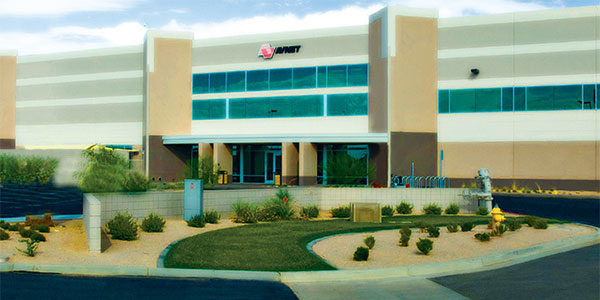Avnet goes lean and green

When Avnet, a giant in the business of configuring and distributing computer and electronics products, opened its new Global Solutions Center in the Phoenix suburb of Chandler, Ariz., just over five years ago, it was the culmination of a process driven by business necessity.
But the new facility, which combines logistics and production under one roof, wasn't just about more space and consolidating what had been scattered operations in order to handle growing business. It was also intended to be a model of efficiency on two fronts. The facility itself took advantage of the latest thinking on sustainability in warehousing, bringing about major improvements in energy efficiency, waste reduction, and recycling. And its operations put in place Lean practices that continue to drive productivity gains not only at that warehouse, but also at Avnet's eight other facilities around the world.
Founded in 1921, Avnet started out as what was essentially a distributor of electronic parts, says John Beimfohr, senior director of integration for the company. Today, it is one of the world's largest distributors of electronic components and computer products, reporting $25.5 billion in annual revenue in its 2013 fiscal year. Over time, it also began to offer customers a variety of services such as building branded products for companies like IBM. In the process of expanding its operations, it acquired a number of integration centers that provided different services.
As for what led to the decision to build the Global Solutions Center, there were several factors in play. The company was facing lease expirations for some of its operations in the Phoenix area. But perhaps more importantly, those operations were not meeting Avnet's business needs. "We had taken some of those facilities as far as they could go from an optimization standpoint," Beimfohr says. "We had run out of capacity. The Global Solutions Center was a design that allowed us to collapse multiple operations into one facility."
Today, the company provides a number of services at the 228,000-square-foot Global Solutions Center (GSC), including hardware integration, software configuration, systems maintenance, assembly, packaging, and logistics. The facility can build and ship up to 700,000 systems a year.
Avnet's goal in building the GSC was not only to consolidate existing operations, but also to handle growth in demand for its highly complex integration services and provide space for building what are sometimes enormous systems. Efficiency and a commitment to continuous improvement also drove the plan. "We wanted to Lean out as much as possible," Beimfohr says. "We had started our Lean journey several years before out of sheer necessity because we ran out of capacity."
LEAN PRACTICES AT THE CORE
Today, both the plant and the warehouse maintain a strong focus on continuous improvement, which is a key principle of Lean operations. "Our goal is to have employees wake up every day seeking ways to improve the process," Beimfohr says. "And then we have a management team that shamelessly rewards our folks when they come up with new ideas."
While the Lean practices were originally adopted as a way to meet capacity challenges, they are now embedded in the Avnet culture, Beimfohr says. All employees—the operation has about 320 people on staff, on average—are expected to offer suggestions for improvement as part of their job and are evaluated on their contributions during annual reviews.
The very design of the warehouse also reflects that relentless focus on efficiency. It is configured for the direct flow of production materials to the shop floor. "We built the rack configuration to complement the flow of product through the integration center," Beimfohr explains. "It is a direct flow of material from pick through the production process. That has been a huge improvement for us. That was Lean Initiative One. Lean Initiative Two was to build our shipping and our receiving areas identically. That way, during peak periods, we are able to extend the receiving area into the shipping area early in the morning and vice versa late in the day."
To make the best possible use of space, the warehouse was designed with very narrow aisles, Beimfohr says. For its lift trucks, the company chose Hyster very-narrow-aisle man-up order pickers that are controlled by a wire-guided system while in the aisles. Workers operate the trucks manually outside of the aisles.
When Avnet built the GSC, it installed a RedPrairie (now JDA) warehouse management system (WMS) for the facility. It is now deploying that system in all of its warehouses around the world. The WMS drops pick orders to associates, who select products using radio-frequency (RF) scanners.
The combination of the WMS and the efficient layout has allowed implementation of a just-in-time (JIT) production system in the integration center, Beimfohr says. "That means we're delivering material to the center within a couple of hours of when it's intended to be consumed, where we used to queue up an entire day's worth of work. As a result, our inbound staging areas are significantly smaller."
GOING GREEN
In addition to its commitment to Lean operating principles, Avnet made sustainability a priority in the center's design and business practices. Because its customers haven't asked for it, Avnet decided not to pursue certification under the Leadership in Energy & Environmental Design (LEED) standards promulgated by the U.S. Green Building Council, which can be a costly undertaking. However, it did keep those standards near at hand as it went about the process of designing the facility. The building's design and operation meet the LEED Silver standards, the third-highest category of certification.
The production and warehouse operations do have the ISO 14001 certification. That standard establishes criteria for an environmental management system. The ISO website says adopting the system "can provide assurance to company management and employees as well as external stakeholders that environmental impact is being measured and improved."
The building incorporates a number of features that promote sustainability. For example, to conserve energy, it includes high-density insulation in the warehouse ceiling and high UV coatings on windows that minimize heat coming through glass. Lighting is programmed to shut off in unoccupied areas. Several times since the site's opening, the company has upgraded the systems that manage air conditioning to wring ever more efficiencies from them.
The company's sustainability accomplishments also include recycling nearly a ton of cardboard every day, according to Beimfohr. "Just the sheer volume indicated to us how much of a difference we could make if we truly tried to find a way to recycle all the byproducts of our warehousing and integration process," he says.
Today, Avnet recycles more than 99 percent of those byproducts—things like CDs, manuals, and packaging that come with the components of the systems it integrates. Further, it has established what it calls the Avnet Refurbishment Program for repairing and recycling systems. The company estimates that the program has kept some 126 tons of electronic waste out of landfills.
That's important to Avnet, Beimfohr says. "Our goal is always to get to 100 percent waste free. We don't want anything going into a landfill," he says. But achieving that has sometimes required a bit of creativity. Beimfohr cites the example of foam, which had proved a challenge to get rid of. The answer turned out to be a type of recycling. "We had an employee find an organization that reuses the material in classrooms," he reports. "We don't have to pay to dispose of it, and it helped the community."
Beimfohr says all of Avnet's U.S. operations have been active in pursuing sustainability practices. Like its Lean practices, many of those initiatives had their start at the GSC. "It's a constant evolution," he says. "We try to leverage the triple bottom line as much as we can. We want an environmental impact, a financial impact, and a social impact. Those will be the ones we will focus on first."
Related Articles

Copyright ©2024. All Rights ReservedDesign, CMS, Hosting & Web Development :: ePublishing